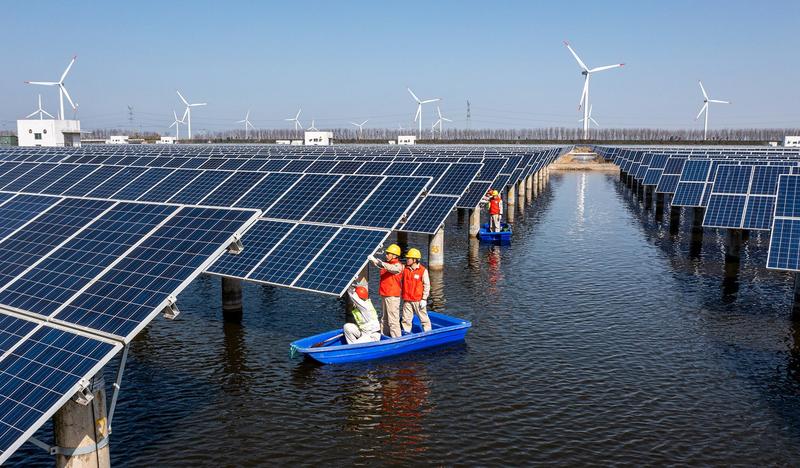 Technicians check out solar panels in Hai'an, Jiangsu province. (ZHAI HUIYONG / FOR CHINA DAILY)
Technicians check out solar panels in Hai'an, Jiangsu province. (ZHAI HUIYONG / FOR CHINA DAILY)
China has vowed to further enhance national energy security through strengthening domestic crude and gas supplies while developing clean energy on a large scale to steadily push forward the country's green energy transition.
The National Energy Administration is targeting 200 million tons of crude production this year, up from last year's 199 million tons, while the goal for domestic natural gas production in 2022 is 214 billion cubic meters, up 4.2 percent year-on-year, according to its annual energy industry guideline published on Tuesday.
Total energy production in China this year is expected to reach around 4.41 billion tons of standard coal, while annual power output is likely to stand at 9.07 trillion kilowatt-hours, it said.
An analyst said that as global energy may be facing shortages due to ongoing geopolitical tensions, it is critical that China boosts domestic energy output so as ensure national energy security.
Luo Zuoxian, head of intelligence and research at the Sinopec Economics and Development Research Institute, said the guideline makes specific targets for each area clear, with particular emphasis on crude output.
The International Energy Agency warned on Tuesday of a global energy shortage owing to economic sanctions on Russia amid the current geopolitical tensions.
Crude production in China reached 215 million tons in 2015 and dropped below 200 million tons in 2016, followed by consecutive decreases in output, according to the National Bureau of Statistics.
It rose to 199 million tons last year as the country vowed to step up domestic crude production of major oil players like China National Petroleum Corp and China Petroleum and Chemical Corp, the country's largest oil refiner.
China also sees natural gas as a key bridging fuel on the way to eventually realize its ambitions of achieving carbon neutrality by 2060. Natural gas production grew 8.2 percent last year to 205.3 billion cubic meters, according to the administration.
Of the total, the administration is aiming for wind and solar to supply a combined share of 12.2 percent, up from 11 percent last year. China, meanwhile, continues to reduce the proportion of coal used, aiming for nonfossil fuel energy to account for 17.3 percent of total energy use this year, up from 16 percent in 2020.
China's wind and solar power generation output has for the first time exceeded 10 percent of total power consumption, reaching 11.7 percent last year. Total solar and wind power generation rose 35 percent year-on-year to 978.5 billion kWh. Distributed solar installed capacity accounted for 55 percent of total photovoltaic capacity-for the first time exceeding 50 percent, it said.
The administration is urging local governments to continuously push forward ongoing rooftop solar PV installations in the country, as the country plans to make renewable energy a key cornerstone in the country's path to a greener economy.
Rooftop installations in China rose to 27.3 gigawatts in 2021 from 19.4 GW in 2017, and the growth should keep rising for the market segment, according to a recent report by Rystad Energy.
Luo said the government's ambitions to gradually increase the output of natural gas as well as nonfossil fuels have also helped lay a solid foundation for the country's ongoing green energy transition, which is also in accordance with the country's modern energy system plan under the 14th Five-Year Plan (2021-25) by the National Development and Reform Commission and the NEA last week.
The plan emphasizes that China's share of nonfossil energy consumption is to increase to around 20 percent by 2025 and the proportion of nonfossil power generation will be around 39 percent by then.
It also vowed to raise its annual comprehensive energy production capacity to more than 4.6 billion tons of standard coal by 2025, while gradually developing solar and wind power on a large scale with high quality, together with steady construction of coastal nuclear power projects with an emphasis on security. Installed capacity for nuclear power plants in operation will reach 70 million kilowatts by 2025, it said.


